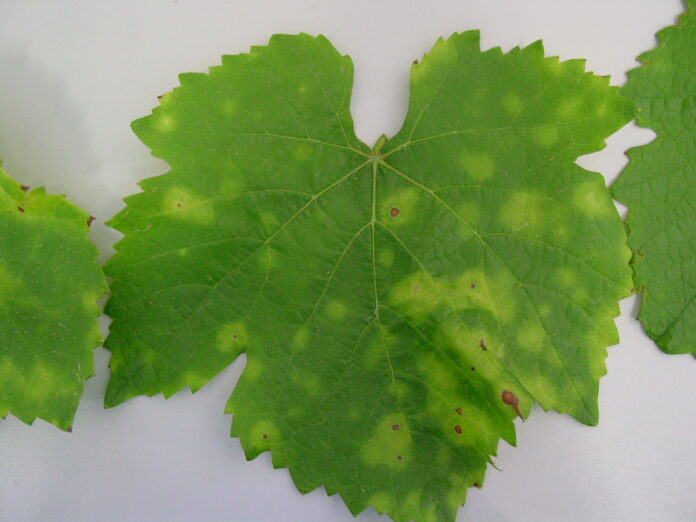Downy mildew of grape:
- In 1878, grape leaves in some French vine yards began to show whitish downy spots on their underside, upper side leaf corresponding to the underside downy spots became yellow at first and turn brownish black and died. Then the causal organism was known.
- French botany professor Pierre Alexis Millardet noticed the plants along dirt road had a bluish film on their leaves and the leaves were still alive.
- The bluish film was found to be copper sulfate and so later mixed with some hydrated lime to better stick on the leaves. Finally, in1885, 8:8:100 mixture i.e. Bordeaux mixture was used.
Etiology: Plasmopara viticola
- Obligate parasite
- Mycelium intercellular, coenocytic, thin walled hyaline hyphae with vesicular haustoria
- Sporangiophores are branched at right angle and emerge from the stomata bearing numerous sporangia at the tips.
- Growth of sporangiophores and sporangia ultimately gives the downy appearance from which the disease has derived its common name downy mildew.
- Sporangia on maturity are disseminated by wind. They germinate as a rule by the formation of zoospores produced by the sporangia.
- Fungal growth spores are abundantly formed at night time.
- Sporangia oval or lemon shaped, zoospore pear or lemon shaped with two apical flagella.
Symptoms of Downy mildew of grape:
- First symptom of infection appears as small yellowish specks, mostly on upper surface of leaves which spreads rapidly in 4-5 days
- Fungus spreads inside the tissue rapidly and within 10 to 15 days the major area of the leaf becomes covered with downy growth on lower surface
- Affected leaf become brown, dry up and premature defoliation occurs
- The disease also spreads to the young growing stem, tendrils, the inflorescence and developing berries
- The affected stem is retarded in growth, become swollen irregularly due to hypertrophy and dries up at the tip
- Young berries become shriveled, rot and fall.
- All the berries in the bunch turn brown and leathery.
- Affected part bear a water soaked spongy appearance.
Disease cycle and epidemiology on Downy mildew of grape:
Primary source of inoculum: infected diseased debris or oospore which is formed in the leaf and shoot tissues present on the ground or plant. Oospores when get favorable environment, germinate and give sporangium and at low temperature produce zoospore which become later encysted and enter through stomata or lenticels and cause leaf infection. Secondary inoculums: sporangia
- Spread of disease is much favored by cool nights combined with early morning dew deposition on the plant parts
- Ideal temperature for germination of sporangia 10 to 230c and minimum 50c
- High RH and cloudy conditions favor disease development
- No formation of sporangiospore and sporangia if the atmospheric conditions become dry and hot.
Management of Downy mildew of grape:
- Removing the crop debris of all diseased leaves, shoots and berries that may contain oospores and mycelia
- All the prunnings should be burned. Maintaining the proper space so that the lower leaves do not touch the soil, this also permit aeration and lower down RH.
- Use of resistant varieties like Cardinal, Champa.
- Application of Bordeaux mixture 4:4:50 (CuSO4, CaO, Water) copper oxychloride (Blitox-50) (0.3%), zineb, maneb and mancozeb (0.2%):
- Immediately after pruning, 3-4 weeks after pruning
- Before bud open, when berries are formed
- During growth of seeds
Spraying should be stopped two weeks prior to harvesting.
